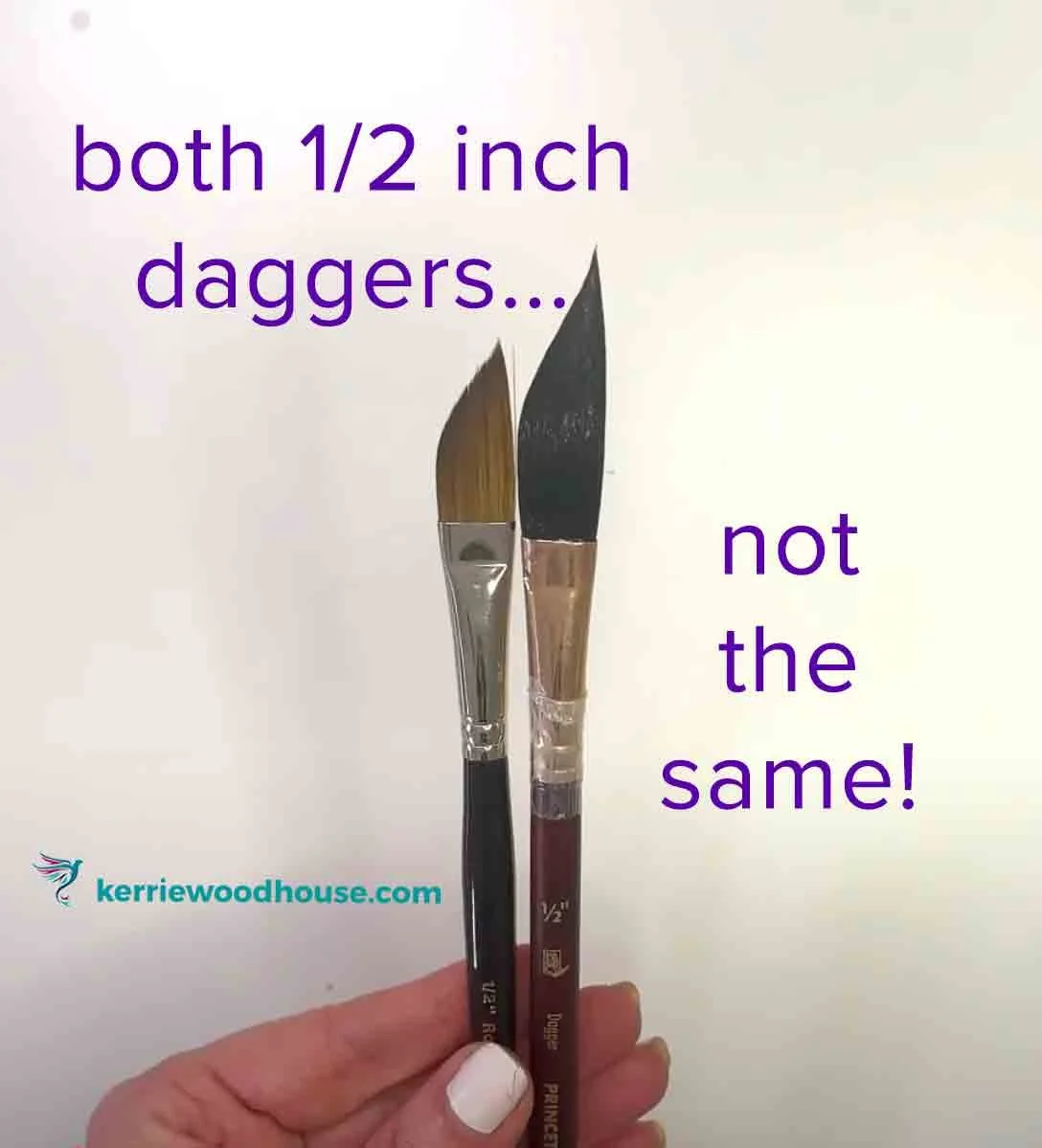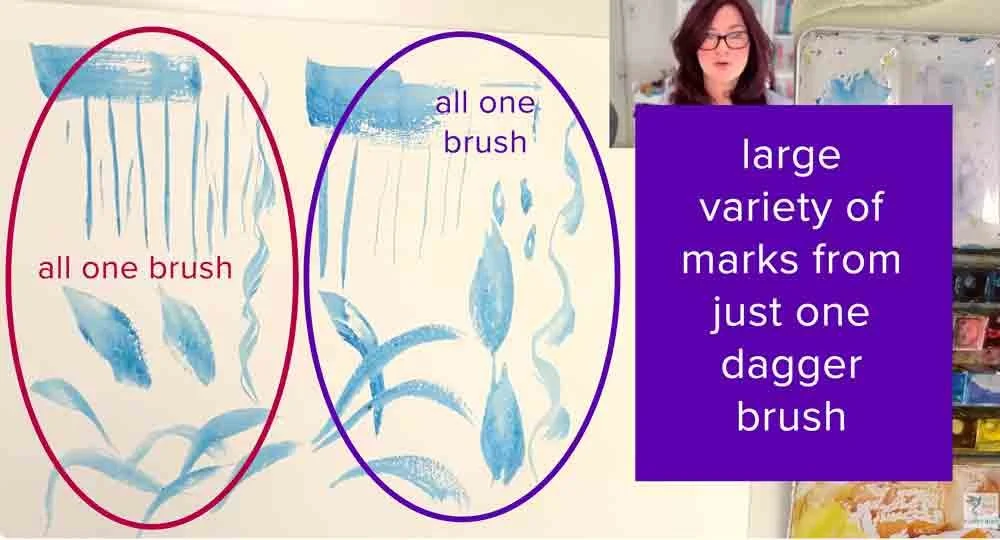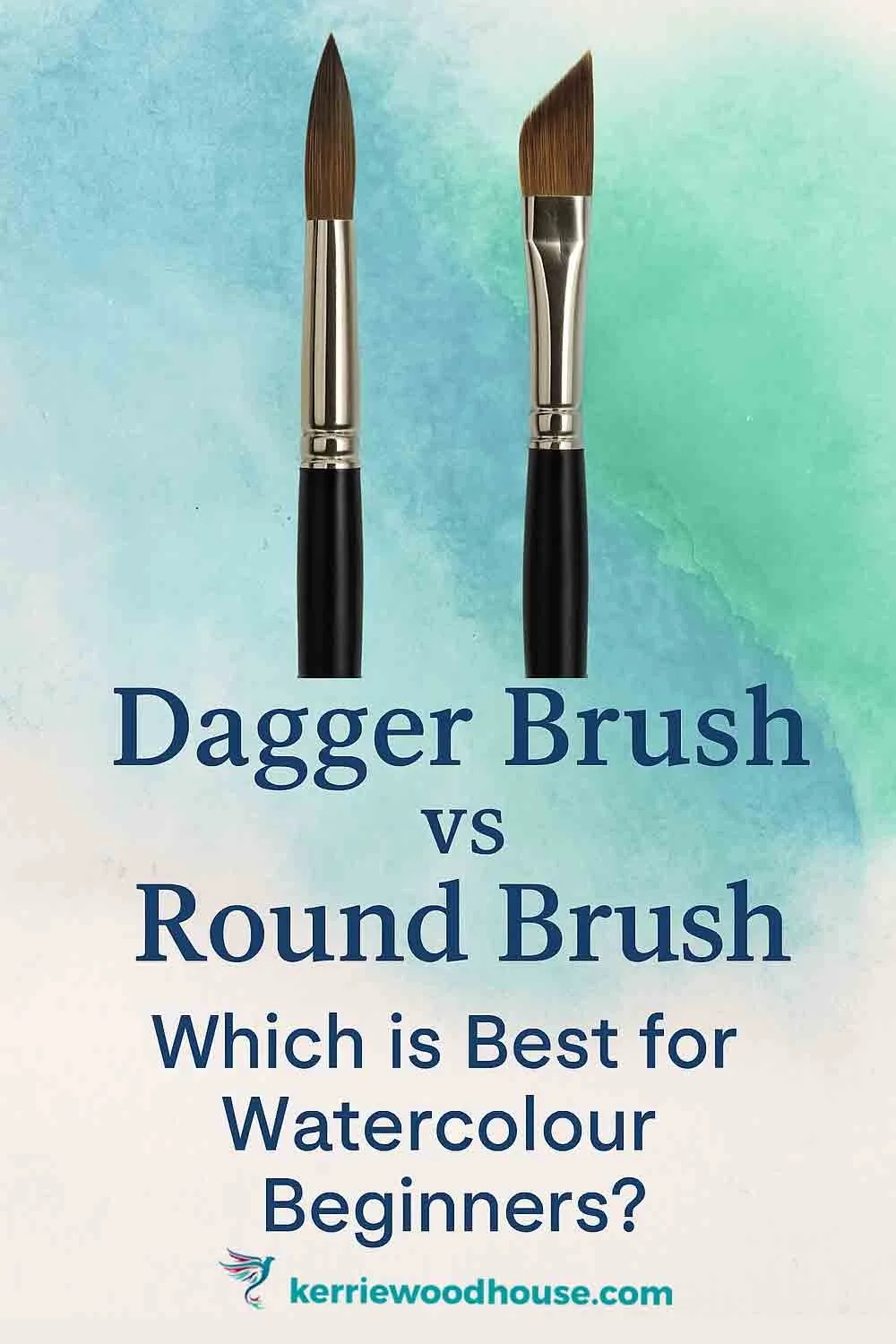Is the Dagger Brush the Best Watercolour Brush for Beginners? (Honest Review)
Disclosure: This post may contain affiliate links. That means if you buy something we may possibly get a small commission at no extra cost to you.
Is the dagger the brush all watercolour painters should be using, or is my old favourite still the best all-rounder?
I recently heard someone suggesting that the dagger should be the brush recommended to all beginners because it does so many things. This made me dig out my daggers and have a proper play with them to see if I might share that opinion.
Let me show you the dagger brushes I've tried and what they can do, so you can figure out if it's the sort of thing you'd like to add to your painting kit.
What Is a Dagger Brush?
A dagger brush is so-called because of its distinctive shape, and I like to think of it as a sort of Swiss Army knife of watercolour brushes. It's really like a combination of multiple brushes that you may already have or have been contemplating, which from that point of view makes it quite versatile.
The dagger is a bit like an oval wash brush (also called a cat's tongue) cut in half. It's also quite like a flat brush because it is flat at the base where the bristles are held, which means it makes nice, quite broad flat marks. Similar to flat brushes, it's sold by measurement size rather than an unhelpful number system - so you'll see sizes like "half inch" with the same sort of inch-based measurement you get when buying flats.
This is actually quite helpful compared to round brushes, which are usually sold based on their size as a number. These numbers are completely inconsistent across brands, so if some watercolour teacher tells you to get a number eight round, that's completely unhelpful advice unless they tell you which brand they're talking about!
How Dagger Brushes Vary Between Manufacturers
Here's something important to note: while that inch-based measurement is quite helpful for understanding how wide the base of your brush is going to be at the ferrule, the actual shape of the dagger brush is quite different from manufacturer to manufacturer.
For example, I've got two half-inch daggers - one from Princeton (with very soft bristles from their Neptune range) and one from Rosemary and Co. (with much firmer bristles from their Red Dot range). Even though they're both half-inch brushes, they're quite different. The Princeton takes a lot more paint and gives you a much bigger mark on the page, even though it's actually the same size across the base.
What Makes the Dagger So Versatile?
The dagger combines elements of several brush types:
Like an oval wash brush: It has that flattened, angular shape that's perfect for broad washes and varied strokes.
Like a flat brush: The flat base creates lovely broad, flat marks, and you can paint straight lines much more easily than with a round brush tip.
Like a rigger: Because daggers have long bristles, they behave a bit like a rigger brush, making very expressive marks that are loose and unpredictable - exactly the sort of painting I tend to favour.
(This is the set I use, which is very reasonably priced, and contains all 3 of these types of brush, and a couple of rounds.)
To my mind, you can use the dagger pretty much as if it was a round, but it's also going to behave a little bit like each of those other brushes at the same time.
What Can You Actually Do With a Dagger Brush?
Let me walk you through the techniques I discovered during my testing:
Broad Marks and Washes
Even though my dagger brush was only a half inch I could actually make a super broad mark - much bigger than a half inch because of that angled shape. With a flat brush that size you'd only be able to make a half-inch wide mark.
Straight Lines
You can turn the brush vertically (or horizontally) and paint with that long edge to put in quite effective long, straight lines. Painting a straightish line is much easier with this broad tool than with the tip of a round because you're using a broader tool that's putting in more of the mark as you go.
Fine Detail Work
Because the tip is so fine, you can actually draw with the very tip and get an even finer mark. Using it almost perpendicular to the page, you can get hair-like marks.
Variable Pressure Effects
You can get varied marks by changing the pressure - going very fine, then applying a bit more pressure, then fine again. The hairs break up and give you rather a lovely, fun effect.
Natural Shapes
I found the shape quite nice for getting into corners if you're trying to paint the corner of a leaf or a petal. I kept ending up painting petal shapes - it was encouraging me to make droopy tulip leaves and things like that.
The Learning Curve Challenge
This versatility comes with a catch: there's quite a learning curve to using a dagger brush effectively. Because they're so different across manufacturers, I haven't really found one that I've fallen in love with yet.
I do find working from small palettes a bit awkward - the dagger can be challenging to get into half pans, and because it's got so many bristles, it does take a lot of paint. (Though that's actually a very good thing in a watercolour brush if you ask me - you want it holding lots of gorgeous, juicy colour.)
The softer the bristles are, the harder they are to control. If you're a painter who likes to do very detailed drawings, you probably won't enjoy this sort of brush. But if you like loose, expressive painting and you like to let the paint do a little bit more collaborating, then this can be a lovely thing to paint with.
Getting Comfortable With Your Dagger Brush
If you've got a little bit of time to spare and want to do a bit of painting but aren't sure what to paint, I'd recommend filling a page with just brush marks. Don't think of it as a waste of paper - think of it as an exploration of your supplies and what you can do with them.
Part of the reason I haven't been using the dagger very much is that I just don't feel comfortable with it, and I don't feel comfortable with it because I don't paint with it a lot. The more you paint with it, the more you're going to get out of it. It's much easier to clock up that practice with simple exercises than trying to do a full painting straight away.
My Honest Verdict: Round Brushes Still Win
So, should the dagger be recommended to all beginners? Here's my honest take:
If you were buying just one brush, if you wanted to limit yourself to one brush for watercolour, my top recommendation would still be a nice big round brush.
My current favourites include mop brushes (which hold lots and lots of paint and are often very expressive), standard rounds with snappy bristles (much easier to control, like the ones in the Zen Art set), and softer rounds for more expressive work (like the Princeton Neptune).
A round brush can do pretty much all the things a dagger can do, but it's more controllable. You can still get fine marks, and if you fill it with enough paint and press the whole belly down, you can get quite wide marks too.
(At the moment, I find myself painting most with this Raven Mop)
The Bottom Line
The dagger brush is undoubtedly versatile - it really is like a Swiss Army knife of watercolour brushes. It's a lot of fun to play with, and once you've got it in your hand, it does encourage you to make expressive marks.
However, that versatility comes with complexity. There's a steeper learning curve, and the brushes vary significantly between manufacturers. For beginners, I still believe a quality round brush offers the best balance of versatility and controllability.
That said, if you enjoy loose, expressive painting and don't mind spending time getting comfortable with a more challenging tool, a dagger brush could be a wonderful addition to your kit. Just don't expect it to be your only brush - think of it as a specialist tool that excels in certain situations rather than a replacement for your trusty round.
Looking for even more information about watercolour supplies?
I have an entire class all about that!
Even better… its completely FREE, and you can join it now 👇
The Beginner’s Guide to Watercolour Supplies
Are you on your own painting journey?
One of these might be useful…












